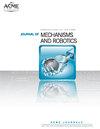基于离散变刚度单元的新型变刚度柔性机器人连杆安全人机交互
IF 3.2
4区 计算机科学
Q2 ENGINEERING, MECHANICAL
Journal of Mechanisms and Robotics-Transactions of the Asme
Pub Date : 2023-03-08
DOI:10.1115/1.4056957
引用次数: 0
摘要
变刚度机器人在需要高刚度的操作性能和低刚度的人机交互安全之间取得平衡。可变刚度连杆在人机交互过程中实现了这种灵活的操作功能。本文提出了一种基于离散变刚度单元(dsu)的变刚度连杆。DSU是一种可以通过改变空心梁段的横截面积特性来离散调节刚度的平行导梁。变刚度连杆(Tri-DSU)由3个串联dsu组成,可实现8种刚度模式和31的刚度比。为了优化设计,通过推导出适用于小/中等挠度的线性分析模型,对DSU和Tri-DSU在不同构型和受力下的刚度进行了分析。该模型采用串接梁和叠加组合的方法推导。建立了3d打印原型,并与有限元分析和分析模型结果进行比较,验证了Tri-DSU的特征和性能。结果表明,该模型能够准确地预测DSU和三DSU在一定参数范围内的刚度。还进行了冲击试验,以验证Tri-DSU的性能。所开发的方法和分析模型可扩展到具有参数配置的多个dsu,实现模块化和定制化,为可重构协作机器人(cobot)机械手的设计提供了工具。本文章由计算机程序翻译,如有差异,请以英文原文为准。
A Novel Variable Stiffness Compliant Robotic Link Based on Discrete Variable Stiffness Units for Safe Human–Robot Interaction
Abstract Variable stiffness manipulators balance the trade-off between manipulation performance needing high stiffness and safe human–robot interaction desiring low stiffness. Variable stiffness links enable this flexible manipulation function during human–robot interaction. In this paper, we propose a novel variable stiffness link based on discrete variable stiffness units (DSUs). A DSU is a parallel guided beam that can adjust stiffness discretely by changing the cross-sectional area properties of the hollow beam segments. The variable stiffness link (Tri-DSU) consists of three tandem DSUs to achieve eight stiffness modes and a stiffness ratio of 31. To optimize the design, stiffness analysis of the DSU and Tri-DSU under various configurations and forces was performed by a derived linear analytical model which applies to small/intermediate deflections. The model is derived using the approach of serially connected beams and superposition combinations. 3D-Printed prototypes were built to verify the feature and performance of the Tri-DSU in comparison with the finite element analysis and analytical model results. It’s demonstrated that our model can accurately predict the stiffnesses of the DSU and Tri-DSU within a certain range of parameters. Impact tests were also conducted to validate the performance of the Tri-DSU. The developed method and analytical model are extendable to multiple DSUs with parameter configurations to achieve modularization and customization, and also provide a tool for the design of reconfigurable collaborative robot (cobot) manipulators.
求助全文
通过发布文献求助,成功后即可免费获取论文全文。
去求助
来源期刊

Journal of Mechanisms and Robotics-Transactions of the Asme
ENGINEERING, MECHANICAL-ROBOTICS
CiteScore
5.60
自引率
15.40%
发文量
131
审稿时长
4.5 months
期刊介绍:
Fundamental theory, algorithms, design, manufacture, and experimental validation for mechanisms and robots; Theoretical and applied kinematics; Mechanism synthesis and design; Analysis and design of robot manipulators, hands and legs, soft robotics, compliant mechanisms, origami and folded robots, printed robots, and haptic devices; Novel fabrication; Actuation and control techniques for mechanisms and robotics; Bio-inspired approaches to mechanism and robot design; Mechanics and design of micro- and nano-scale devices.
 求助内容:
求助内容: 应助结果提醒方式:
应助结果提醒方式:


